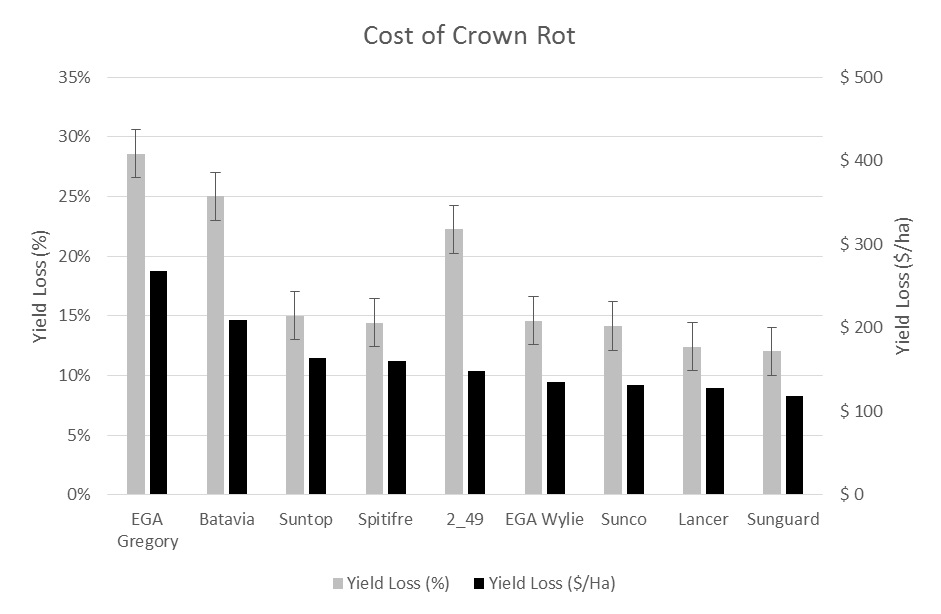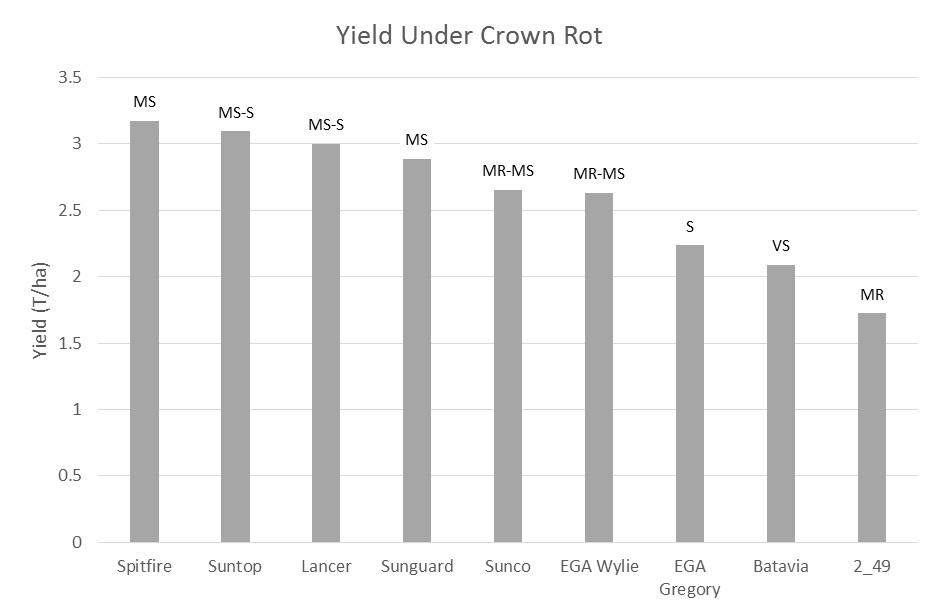Resistance and tolerance Where we are with crown rot breeding
Author: Philip Davies, University of Sydney | Date: 22 Jul 2016
Take home message
Significant variation exists in varieties performance under crown rot, representing opportunities for intervention in crown rot management.
Varietal performance under crown rot is made up separately of resistance and tolerance, as well as the yield potential of the variety.
The current simplistic R to S resistance rating system does not adequately represent a variety’s true performance in crown rot conditions, as it neglects both the tolerance and yield potential of the variety.
A more informative rating system for crown rot is required which accounts for a variety’s resistance and tolerance to crown rot, and the variety’s yield potential.
Background
Crown rot caused by the fungus Fusarium pseudograminearum is a major limiting factor in winter cereal production in the northern region, and continues to emerge as a serious issue in the southern and western regions. The disease is characterised by a light to dark honey-brown discolouration on the base of infected tillers, extending further up the stem in more susceptible varieties. This discolouration is directly related to the invasion of the plant tissue by the pathogen during the infection phase of this disease.
As the pathogen continues to colonise the plant, fungal growth begins to disrupt vascular tissues, interrupting water and nutrient flow up and down tillers. With the increased water and nutrient demands placed on the plant during the post-flowering and grain-fill period, this disruption results in premature ripening of affected heads, causing the typical whiteheads and high screenings. Moisture and heat stress around this period greatly increase the expression of the disease through increased water demands placed on the plant.
The pathogen survives as mycelium (fungal growth) in winter cereal and grass weed residues which had become infected during the season. Whilst stubble breakdown (and thus pathogen survival) is strongly associated with soil temperature and moisture conditions, as long as there is intact cereal residues, viable crown rot inoculum will be present.
Yield losses associated with crown rot can be significant, and while there are no silver bullet solutions to this disease, management strategies and genetic variation within existing varieties are available.
Management options for crown rot generally are associated with reducing the incidence of infection. This includes rotation to non-host crops, often used in conjunction with risk management strategies such as PreDictaB, inter-row sowing, and grass weed management. Whilst these strategies are effective at reducing the incidence of infection, once a plant becomes infected, the resistance and tolerance of the variety determines how the plant responds.
Describing the impact of crown rot
To look at the impact of crown rot, Figure 1 summarises the yield loss experienced in a subset of varieties from a breeding trial in 2015. This suite of varieties represents the range of responses to crown rot, from highly susceptible to resistant, and from intolerant to tolerant.
This trial achieved moderate disease pressure, with approximately 80% of plants infected. The susceptible variety EGA Gregory lost 28% of its yield due to crown rot, compared to Sunguard, which lost 12%. From these figures, it is clear that Sunguard performs better under crown rot than Gregory. This however does not describe why this difference exists.
A varieties performance under crown rot is determined by both resistance and tolerance. These are two separate traits which together determine yield loss. Resistance is the ability of a plant to restrict the infection by the pathogen, or restrict its growth throughout the plant. Tolerance on the other hand is the ability of the plant to yield, despite being infected. Resistance is widely discussed with regards to crown rot, and used to describe how a variety will perform under crown rot (variety sowing guides etc.). Importantly, tolerance equally impacts a varieties response to crown rot but is often not considered.

Figure 1. Yield loss of varieties associated with crown rot, described as both a percentage and in dollar terms, calculated at $300/tonne.
Varieties EGA Gregory, Suntop, Spitfire, EGA Wylie, Lancer and Sunguard are protected under the Plant Breeders Rights Act 1994.
Whilst reporting both resistance and tolerance provides more information from which to base varietal selections, it does not tell the whole story, as it fails to take into account the inherent yield potential of these varieties.

Figure 2. Yield of a suite of wheat varieties under moderate levels of crown rot.
Varieties Spitfire, Suntop, Lancer, Sunguard, EGA Wylie and EGA Gregory protected under the Plant Breeders Rights Act 1994.
This is demonstrated in Figure 2, comparing the yield under crown rot pressure in the same suite of varieties. In this case, even though Sunguard has a lower yield loss, Spitfire, Suntop and Lancer all out performed it under moderate crown rot conditions. The financial impact becomes even more pronounced when you consider that Sunguard is an AH variety compared to the APH classifications of Spitfire, Suntop and Lancer.
While the resistance rating system may be more effective under very high inoculum conditions, under the moderate disease pressure achieved in this trial, the most resistant varieties of EGA Wylie and Sunco were significantly outperformed, and these ratings risk misinforming growers of the true performance of varieties under crown rot conditions.
Varietal selection with respect to crown rot should therefore consider not only the resistance rating of a variety, but also its tolerance and yield potential, along with the level of crown rot inoculum and level of risk a grower is willing to take. Soil starting moisture as a buffer against the potential effects of water and heat stress on disease expression should also factor in decision making.
How do pre-breeders use this information?
Resistance and tolerance represent two distinct genetic traits which can be targeted to reduce the impact of crown rot. By separately assessing both these traits, they can be combined to achieve an additive effect.
The level of resistance of a variety can be assessed by examining the degree of honey-brown discolouration on the lower stem and crown. While time-consuming, this strategy is useful in determining the amount of fungus in the plant, and thus the relative level of susceptibility. Tolerance however is measured in yield loss trials, comparing the amount of yield loss of a breeding line to the amount of stem browning in that line. This allows breeders to identify whether a low yield loss amount can be attributed to resistance or tolerance in that line.
While these trials are useful in a smaller pre-breeding context where accurate identification of crown rot traits is important, they are both too time consuming and expensive to use in a commercial breeding program.
Breeding for crown rot in a commercial context
The use of molecular markers can alleviate some of these issues, by providing breeders with a rapid method of determining whether certain genes or combination of genes are present in a breeding line which confer improved resistance or tolerance to crown rot. Whilst molecular markers are particularly effective for some traits, markers associated with crown rot have some difficulties. There are only a few markers available for a small number of resistance QTLs only, and these are often unreliable, and only loosely linked with the trait.
These issues are being addressed, with recent work identifying a number of markers associated with tolerance traits in a mapping population. These markers will make it easier to breed for tolerance traits without having to resort to yield loss testing. Further, refinement of existing markers for some of the key resistance QTLs is being completed by CSIRO in Brisbane, which will result in more reliable and thus effective in commercial breeding programs.
Along with work on molecular markers, there are also efforts to improve the screening methodologies for resistance and tolerance. Current screening methods are very time consuming and thus expensive to run and have relatively low throughput. Research currently being undertaken at The University of Southern Queensland looking at remote sensing technologies is aiming to improve the screening process. This includes using multispectral imagery to detect differences between resistant and susceptible genotypes, as well as using infrared imagery to look at differences in canopy temperature between tolerant and intolerant lines, as a way of determining plant moisture stress.
Conclusion
Accurate measurement and classification of a varieties performance under crown rot is crucial for varietal selection. This should include resistance, tolerance and the yield potential of a variety. This is similarly the case for breeders, both in a pre-breeding and commercial context, where the resistance and tolerance separately need to be measured, so that these traits can be combined.
Acknowledgements
This research is a collaborative project between The Universities of Sydney and Southern Queensland, and the CSIRO. The research undertaken as part of this project is made possible by the significant contributions of growers through both trial cooperation and the support of the GRDC, the author would like to thank them for their continued support.
Contact details
Philip Davies
Plant Breeding Institute, The University of Sydney
12656 Newell Hwy, Narrabri, NSW, 2390
Ph: 02 6799 2244
Email: philip.davies@sydney.edu.au
Varieties displaying this symbol beside them are protected under the Plant Breeders Rights Act 1994.
GRDC Project Code: US00075,
Was this page helpful?
YOUR FEEDBACK
